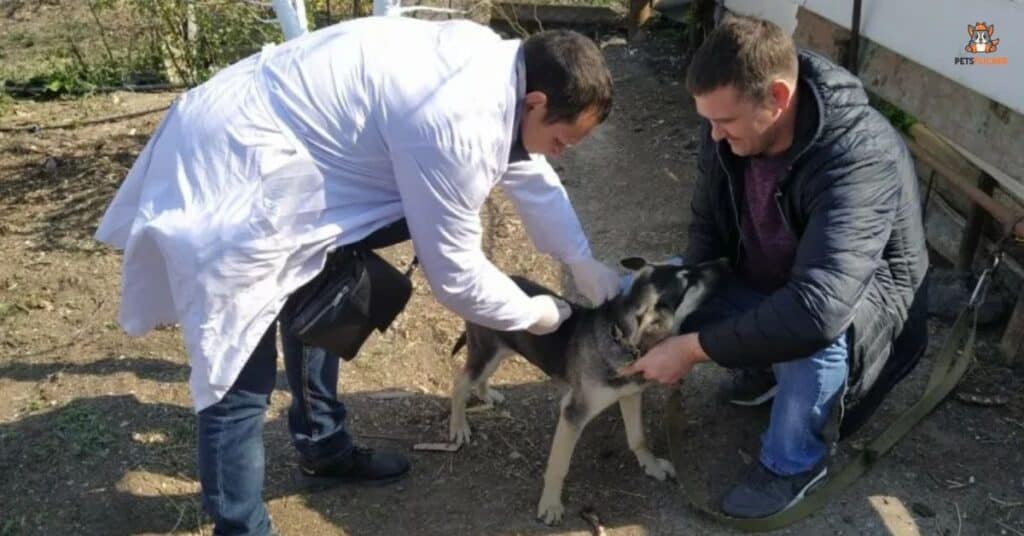Rage Syndrome is a rare canine condition marked by sudden, unprovoked aggression. It can cause dogs to display intense aggression without warning, often leading to dangerous situations.
Rage Syndrome in dogs, also known as sudden-onset aggression, is a rare behavioral disorder characterized by sudden and intense outbursts of aggression. These episodes can occur without any apparent trigger or warning, posing a significant risk to people and other animals around them.
Affected dogs may exhibit behaviors such as growling, snapping, and biting during these episodes, which can be unpredictable and challenging to manage. While the exact cause of Rage Syndrome is not fully understood, it is believed to have genetic and neurological factors contributing to its development.
Potential Causes of Rage Syndrome in Dogs
Rage Syndrome in dogs is characterized by sudden, intense aggression, often without obvious triggers. This behavior can pose significant risks to both humans and other animals.

Signs of Rage Syndrome in dogs include:
- Sudden and intense aggression without obvious triggers
- Growling, snapping, and biting behaviors during episodes
- Unpredictable nature, with friendly behavior at other times
- Potential risk of harm to humans and other animals
Rage Syndrome episodes can be alarming and dangerous, requiring careful management and understanding from dog owners and handlers. Seeking professional guidance and implementing appropriate training and behavioral strategies is crucial for the safety of everyone involved.
| Section | Key Point | Reference |
| Genetic and Breed-Specific Factors | Breed Predisposition: Some breeds are more prone to rage syndrome. | Podberscek & Serpell, 1996 |
| Inheritance Patterns: Possible hereditary patterns in affected breeds. | Shihab et al., 2014 | |
| Neurological Abnormalities | Brain Structure and Function: Studies on parts of the brain controlling aggression and fear. | Dodman et al., 1992 |
| Neurochemical Imbalances: Imbalances in neurotransmitters affecting mood regulation and aggression. | Peremans et al., 2003 | |
| Behavioural Characteristics | Unpredictable Aggression: Sudden, intense, unprovoked aggression. | Hart & Hart, 1985 |
| Age of Onset and Progression: Symptoms typically start in early adulthood. | Overall, 2000 | |
| Differential Diagnosis and Treatment Approaches | Challenges in Diagnosis: Difficulty in differentiating rage syndrome from other aggression types. | Mills & Simpson, 2007 |
| Treatment Modalities: Combination of behaviour modification and pharmacotherapy. | Houpt et al., 2007 | |
| Controversies and Ongoing Research | Debate on Existence and Definition: Ongoing debates about rage syndrome. | Overall, 1997 |
| Need for Further Research: More studies needed on genetics and brain of aggressive dogs. | N/A |
This table provides a clear overview of the key points related to rage syndrome in dogs, including genetic factors, neurological abnormalities, behavioral characteristics, diagnosis challenges, treatment approaches, controversies, and ongoing research.
Related Article: Chemical Castration In Dogs: A Comprehensive Guide
How to Diagnose Rage Syndrome in Dogs
Diagnosing Rage Syndrome in dogs involves observing specific behavioral signs. Veterinarians and behaviorists look for sudden, intense aggression without clear triggers. They also consider the dog’s breed and age, as certain breeds and young adults are more prone.
A thorough physical exam and medical history review are crucial. This helps rule out other potential causes of aggression, such as pain or illness. Blood tests and neurological assessments may also be conducted to rule out underlying medical conditions.
Behavior assessments in controlled environments can help provoke or observe aggressive reactions. These tests may include interactions with unfamiliar people, simulated stressors, or trigger scenarios to assess the dog’s response. Video recordings during these assessments can provide valuable insights.
A comprehensive diagnosis involves considering all factors, including genetic predispositions, behavioral patterns, and medical conditions. Collaboration between veterinarians, behaviorists, and pet owners is key to accurately diagnosing and managing Rage Syndrome in dogs.
Diagnostics for Rage Syndrome

- Observation of Behavioral Signs: Look for sudden, intense aggression without clear triggers.
- Medical History Review: Consider breed, age, and previous incidents of aggression.
- Physical Examination: Rule out other causes of aggression like pain or illness.
- Blood Tests and Neurological Assessments: Identify any underlying medical conditions.
- Behavior Assessments: Conduct tests in controlled environments to provoke aggressive reactions.
- Video Recordings: Capture behaviors during assessments for further analysis.
- Comprehensive Diagnosis: Combine observations, medical findings, and behavioral assessments.
- Collaborative Approach: Work with veterinarians, behaviorists, and pet owners for accurate diagnosis and management.
Would Idiopathic Aggression be More Suitable?
Considering the complexities of diagnosing aggression in dogs, some experts argue that “Idiopathic Aggression” may be a more suitable term. This term acknowledges the unknown or unclear causes of aggressive behavior in some dogs.
Using “Idiopathic Aggression” doesn’t imply a lack of effort in diagnosis but rather highlights the challenges in pinpointing specific triggers or factors. It emphasizes the need for comprehensive assessments and ongoing research to better understand and manage aggressive behaviors in dogs.
How Do You Treat Idiopathic Aggression?
Treating idiopathic aggression in dogs typically involves a multifaceted approach tailored to the individual dog. Behavioral modification techniques, such as desensitization and counterconditioning, aim to change the dog’s response to triggers gradually.
Pharmacotherapy may be recommended in severe cases or when behavioral interventions alone are insufficient. Medications such as selective serotonin reuptake inhibitors (SSRIs) or tricyclic antidepressants (TCAs) can help manage aggression by affecting neurotransmitter levels in the brain.
Treating and Managing Rage Syndrome
Treating and managing Rage Syndrome in dogs requires a comprehensive approach involving behavioral interventions and potentially medication. Behavior modification techniques like positive reinforcement training can help modify aggressive behaviors and teach alternative responses.
Environmental management plays a crucial role in preventing triggers that can lead to aggressive outbursts. Creating a calm and structured environment with clear boundaries and routines can reduce stress and anxiety for the dog.
In severe cases of Rage Syndrome, veterinarians may recommend medication to help manage aggression. This can include medications that affect neurotransmitter levels in the brain, such as SSRIs or TCAs, in combination with behavioral therapy for optimal results.
Treatment Options for Rage Syndrome
Medication:
- Medications like SSRIs or TCAs can help manage aggression by affecting neurotransmitter levels.
- They are often used in combination with behavioral therapy for optimal results.
Behavior Modification:
- Positive reinforcement training can help modify aggressive behaviors and teach alternative responses.
- This approach focuses on rewarding desired behaviors and ignoring or redirecting unwanted behaviors.
Environmental Changes:
- Creating a calm and structured environment with clear boundaries and routines can reduce stress and anxiety.
- Environmental management plays a crucial role in preventing triggers that can lead to aggressive outbursts.
Prevention and Responsible Dog Ownership
Prevention and responsible dog ownership involve taking proactive steps to ensure the well-being and safety of dogs and those around them. This includes proper training, socialization, and providing a suitable environment for their physical and mental needs.

Prevention Measures for Rage Syndrome
Early socialisation: Ensuring dogs are exposed to various people, animals, and environments during their critical developmental period.
Basic training: Teaching dogs basic obedience commands and appropriate behaviors to promote good manners and prevent aggression.
Regular veterinary care: Scheduling routine check-ups, vaccinations, and addressing any health concerns promptly to maintain overall well-being.
Breed research: Understanding breed tendencies and potential predispositions to aggression can help in informed decision-making and proactive management.
Seek professional help: Consulting with veterinarians, behaviorists, or trainers for guidance on managing behavioral issues and implementing effective preventive strategies.
Related Article: Best Dog Walk In Glasgow
Management & Worst-Case Scenario
Management of rage syndrome in dogs involves creating a safe environment and implementing behavioral strategies. This includes identifying triggers and avoiding situations that may lead to aggressive outbursts.
In worst-case scenarios where aggression cannot be controlled or poses a significant risk, professional guidance and intervention are crucial. This may include specialized training programs, behavior modification techniques, and, in severe cases, medication prescribed by a veterinarian.
Pet owners should always prioritize safety and seek help from qualified professionals if they are unable to manage aggressive behavior effectively. Early intervention and consistent management strategies can improve the quality of life for both the dog and its human companions.
Customised Treatment Plans for Aggressive Behaviour in Dogs
Customized treatment plans for aggressive behavior in dogs are tailored to address the specific triggers and underlying causes of aggression. This may involve a combination of behavioral modification techniques, environmental changes, and sometimes medication.
The first step in developing a customized treatment plan is to conduct a thorough assessment of the dog’s behavior. This includes observing triggers, evaluating the dog’s response, and identifying any patterns or potential medical issues.
Based on the assessment findings, a comprehensive plan is created, which may include positive reinforcement training, desensitization and counterconditioning exercises, management of environmental stressors, and ongoing monitoring and adjustments as needed.
Living with a Dog with a History of Aggression
Living with a dog with a history of aggression requires understanding triggers and implementing safety measures. Consistent training, socialization, and professional guidance can help manage and improve behavior.

Managing Rage Syndrome in Dogs
Establish a Safe Space: Create a designated area where the dog feels secure and can retreat during stressful situations.
Use Positive Reinforcement: Reward desired behaviors with treats or praise to encourage positive responses and discourage aggression.
Implement a Consistent Routine: Maintain a predictable schedule for feeding, exercise, and training sessions to reduce anxiety and promote stability.
Educate Family Members and Friends: Inform people about the dog’s triggers and appropriate interactions to prevent conflicts and ensure safety.
Seek Ongoing Support: Consult with veterinarians, behaviorists, or trainers regularly for guidance and adjustments to management strategies.
Frequently Asked Questions
What are some common triggers for rage syndrome in dogs?
Common triggers can include fear, stress, and certain environmental stimuli.
How can early socialization help prevent aggressive behavior in dogs?
Early socialization exposes dogs to various people, animals, and environments, teaching them to adapt and reducing the likelihood of aggression.
What role does positive reinforcement play in managing rage syndrome?
Positive reinforcement techniques reward desired behaviors, encouraging calm responses and discouraging aggression.
Why is it important to establish a consistent routine for dogs with a history of aggression?
A consistent routine provides stability and reduces anxiety, which can help prevent aggressive outbursts.
How can family members and friends contribute to managing a dog’s aggressive behavior?
Educating them about the dog’s triggers and appropriate interactions can prevent conflicts and ensure a safe environment.
When should pet owners seek ongoing support for managing rage syndrome in their dogs?
Pet owners should seek ongoing support from professionals like veterinarians or behaviorists to make necessary adjustments to management strategies and ensure the dog’s well-being.
Final Words
Rage Syndrome in dogs is a complex behavioral disorder that requires careful management and understanding. By identifying triggers, implementing positive reinforcement techniques, and creating a safe environment, pet owners can help mitigate aggressive outbursts.
Early socialization, consistent routines, and ongoing support from professionals are key in managing rage syndrome effectively. Educating family members and friends about the dog’s needs and triggers also plays a crucial role in maintaining a harmonious environment for both the dog and its human companions.

Elax is a seasoned writer with five years of experience specializing in articles focused on pets. His passion for animals and extensive knowledge shines through his engaging and informative writing style, captivating readers with insights into pet care and companionship. With a knack for crafting compelling content, Elax brings a wealth of expertise to the realm of pet-centric literature on your website.







